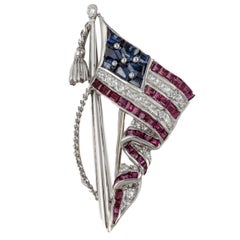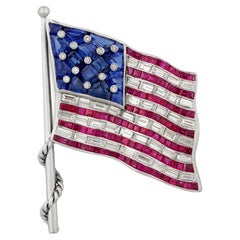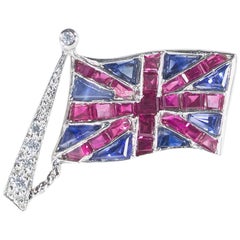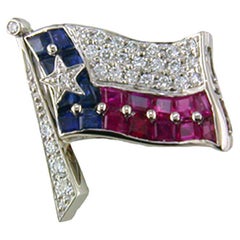Oscar Heyman Flag
Vintage 1960s American Brooches
Diamond, Ruby, Sapphire, Platinum
21st Century and Contemporary American Modern Brooches
Diamond, Ruby, Sapphire, Platinum
2010s American Contemporary Brooches
Diamond, Ruby, Sapphire, Platinum
Recent Sales
21st Century and Contemporary American Modern Brooches
White Diamond, Ruby, Sapphire, Platinum
2010s American Contemporary Brooches
Diamond, Ruby, Sapphire, Platinum
American Brooches
People Also Browsed
21st Century and Contemporary Contemporary Charm Bracelets
Diamond, Gold, 18k Gold, White Gold
Vintage 1920s American Art Deco Cocktail Rings
Diamond, Emerald, Platinum
Vintage 1930s French Art Deco Brooches
Turquoise, White Diamond, Diamond, Enamel, White Gold, 18k Gold, Gold
Vintage 1970s American Modernist Pendant Necklaces
Gold, 18k Gold, Yellow Gold
Vintage 1970s American Modernist Cufflinks
Gold, Yellow Gold, 18k Gold
2010s Evening Bags and Minaudières
21st Century and Contemporary French Globes
1990s French Jackets
2010s American Contemporary Dome Rings
Diamond, Sapphire, Platinum
1990s English Shirts
21st Century and Contemporary American Cocktail Rings
Diamond, Platinum
Vintage 1980s Clip-on Earrings
Lapis Lazuli, Yellow Gold
2010s American Contemporary Dome Rings
Sapphire, Platinum
Vintage 1930s American Retro Brooches
Amethyst, Diamond, Pearl, Peridot, Sapphire, 14k Gold
Vintage 1920s Swiss Art Deco Wrist Watches
20th Century French Art Nouveau Brooches
Citrine, Diamond, 18k Gold, Yellow Gold, Enamel
Oscar Heyman for sale on 1stDibs
Known as “the jewelers’ jeweler,” Oscar Heyman (1888–1970) designed pieces for Cartier, Tiffany & Co., Van Cleef & Arpels, Harry Winston and Black, Starr & Frost. The family-run Oscar Heyman & Brothers jewelry company was founded by Heyman with his brothers Nathan and Harry in 1912. Jewelers from Latvia, they had trained at their great-uncle’s workshop, which had clients including Russian imperial jeweler Fabergé, before immigrating to the United States in the early 1900s.
After arriving in New York, Oscar worked with Pierre Cartier and Nathan was a tool maker at Western Electric before they came together to open their jewelry business. Highly skilled craftsmen, the Heyman brothers quickly developed a roster of high-profile clients — primarily big-name jewelers — drawn to their work with dazzling stones and meticulous design. In 1917, Black, Starr & Frost commissioned the brothers to design an American flag brooch, which would become a recurring motif in the Oscar Heyman & Brothers portfolio. They also designed the Pansy brooch in the 1930s, another long-popular accessory that was produced exclusively for Tiffany & Co. toward the end of the 20th century. After Heyman designed for four of the five jewelers on view at the 1939 World’s Fair House of Jewels (Cartier, Udall & Ballou, Marcus & Co. and Black, Starr & Frost), the company was given the moniker “the jewelers’ jeweler.”
Heyman & Brothers later designed gem-encrusted medallions that traveled to the moon on Apollo 16, the necklace setting for the 69-carat diamond Richard Burton gave Elizabeth Taylor in 1969 and even a pair of ruby-encrusted Stuart Weitzman stilettos in 2003. Over the years, the company has entranced such clients as Evelyn Lauder, Marjorie Merriweather Post, Billy Porter and Tina Fey with its pieces.
In 2012, the century-old jeweler underwent a rebranding to simplify its name to Oscar Heyman and today is still run by the Heyman family, which manages the whole process from alloying their own metal to cutting and polishing their gemstones to assembling the final product in-house. In 2017, the Museum of Fine Arts, Boston published a monograph authored by Yvonne J. Markowitz and Elizabeth Hamilton that details for a broader audience the history of Oscar Heyman, an unsung company that’s long been behind some of the biggest names in jewelry.
Shop authentic Oscar Heyman rings, brooches and bracelets on 1stDibs.
The Legacy of Diamond in Jewelry Design
Antique diamond rings, diamond tiaras and dazzling vintage diamond earrings are on the wish lists of every lover of fine jewelry. And diamonds and diamond jewelry are primarily associated with storybook engagements and red-carpet grand entrances — indeed, this ultra-cherished gemstone has a dramatic history on its hands.
From “A Diamond Is Forever” to “Diamonds Are a Girl’s Best Friend,” pop culture has ingrained in our minds that diamonds are the most desired, the most lasting and the most valuable gemstone. But what makes the diamond so special? Each stone — whether it’s rubies, sapphires or another stone — is unique and important in its own right. April babies might claim diamonds for themselves, but just about everyone wants this kind of sparkle in their lives!
There are several factors that set diamonds apart from other stones, and these points are important to our gem education.
Diamonds are minerals. They are made up of almost entirely of carbon (carbon comprises 99.95 percent; the remainder consists of various trace elements). Diamonds are the hardest gemstones, ranking number 10 on the Mohs Hardness Scale. Even its name, diamond, is rooted in the Greek adamas, or unconquerable. The only object that can scratch a diamond is another diamond. Diamonds are formed deep within the earth at very high temperatures (1,652–2,372 degrees Fahrenheit at depths between 90 and 120 miles beneath the earth’s surface) and are carried up by volcanic activity. Diamonds are quite rare, according to the Gemological Institute of America, and only 30 percent of all the diamonds mined in the world are gem quality.
In the 1950s, the Gemological Institute of America developed the 4Cs grading system to classify diamonds: clarity, color, cut and carat weight. Not all diamonds are created equal (there are diamonds, and then there are diamonds). The value of the diamond depends on the clarity (flawless diamonds are very rare but a diamond's value decreases if there are many blemishes or inclusions), color (the less color the higher the grade), cut (how the diamond’s facets catch the light, certain cuts of diamonds show off the stone better than others) and carat weight (the bigger, the better).
When you start shopping for a diamond engagement ring, always prioritize the cut, which plays the largest role in the diamond's beauty (taking the time to clean your diamond ring at least every six months or so plays a role in maintaining said beauty). And on 1stDibs, a range of buying guides can be found for those in the market for antique engagement rings, vintage engagement rings or Art Deco engagement rings.
Shop antique and vintage diamond rings, diamond necklaces and other extraordinary diamond jewelry on 1stDibs.
Finding the Right Brooches for You
Vintage brooches, which refer to decorative jewelry traditionally pinned to garments and used to fasten pieces of clothing together where needed, have seen increasing popularity in recent years.
While jewelry trends come and go, brooches are indeed back on the radar thanks to fashion houses like Gucci, Versace, Dior and Saint Laurent, all of which feature fun pinnable designs in their current collections. Whether a dazzlingly naturalistic Art Nouveau dragonfly, a whimsical David Webb animal, a gem-studded bloom or a streamlined abstract design, these jewels add color and sparkle to your look and a spring to your step.
Given their long history, brooches have expectedly taken on a variety of different shapes and forms over time, with jewelers turning to assorted methods of ornamentation for these accessories, including enameling and the integration of pearls and gemstones. Cameo brooches that originated during the Victorian age are characterized by a shell carved in raised relief that feature portraits of a woman’s profile, while 19th-century micromosaic brooches, comprising innumerable individually placed glass fragments, sometimes feature miniature depictions of a pastoral scene in daily Roman life.
At one time, brooches were symbols of wealth, made primarily from the finest metals and showcasing exquisite precious gemstones. Today, these jewels are inclusive and universal, and you don’t have to travel very far to find an admirer of brooches. They can be richly geometric in form, such as the ornate diamond pins dating from the Art Deco era, or designer-specific, such as the celebrated naturalistic works created by Tiffany & Co., the milk glass and gold confections crafted by Trifari or handmade vintage Chanel brooches of silk or laminated sheer fabric. Chanel, of course, has never abandoned this style, producing gorgeously baroque CC examples since the 1980s.
Brooches are versatile and adaptable. These decorative accessories can be worn in your hair, on hats, scarves and on the lower point of V-neck clothing. Pin a dazzling brooch to the lapel of your blazer-and-tee combo or add a cluster of smaller pins to your overcoat. And while brooches have their place in “mourning jewelry,” in that a mourning brooch is representative of your connection to a lost loved one, they’re widely seen as romantic and symbolic of love, so much so that a hardcore brooch enthusiast might advocate for brooches to be worn over the heart.
Today, find a wide variety of antique and vintage brooches for sale on 1stDibs, including gold brooches, sapphire brooches and more.




